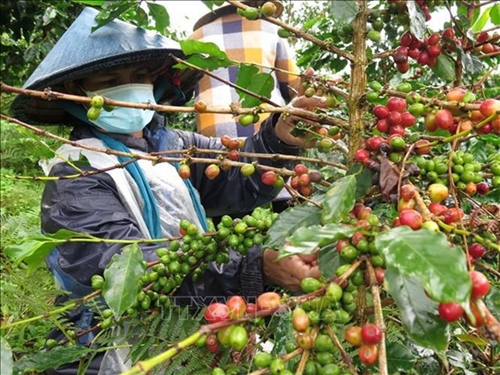October 14, 2022 | 17:21 (GMT+7)
German newspaper highlights climate change impact on Vietnamese coffee growers
Die Rheinpfalz, a daily newspaper in the German western state of Rhineland-Palatinate, has just published an article about heavy climate change-induced consequences facing coffee growers in Vietnam. Germany is currently the Southeast Asian nation’s largest importer of Robusta coffee.
According to the article, coffee grows well in the highlands of Vietnam, where about 1.5 million people live on coffee cultivation. However, water sources for coffee farming in the region are becoming increasingly scarce due to the impact of climate change which has affected the country for a long time.
    |
 |
|
Farmers in Mang Den town, Kon Plong district, the Central Highlands province of Kon Tum harvest coffee. |
The rainy season in the region is becoming more and more erratic, even without rain at all, as in June this year. When it needs rain for the coffee tree to grow, the weather is hot; but when the tree blooms, it suddenly rains, causing the flowers to rot. This reduces coffee production and quality.
The article noted that coffee exports, with the majority heading for the European market, have declined. Vietnam shipped 1.88 million tons of coffee overseas in 2018, with the figure continuously decreasing to 1.61 million tons in 2019, 1.57 million tons in 2020, and 1.52 million in 2021.
The author went on to added that state agencies and NGOs are trying to find solutions to help the country’s coffee industry become more resilient and sustainable. The Vietnamese Ministry of Agriculture and Rural Development has launched a 2021-2025 project on the replanting or grafting of about 107,000 hectares of coffee with new varieties that are more resistant to pests and diseases and more adaptable to climate change conditions.
The article highlighted that Vietnam is currently the second largest coffee producer in the world (after Brazil) and the largest producer of Robusta coffee in the world. The nation’s customers are in about 80 countries across the globe and 40% of its coffee output is exported to Europe. Germany is Vietnam’s most important consumer market, accounting for 15% of its total coffee exports in 2021. According to the German Federal Statistical Office, Germany imported a total of 1.21 million tonnes of coffee last year, of which 17% were from Vietnam.
Source: VNA